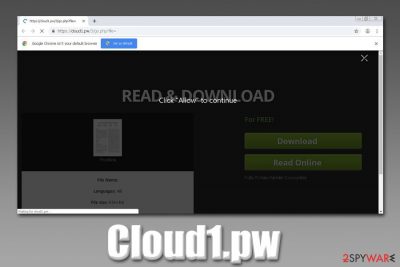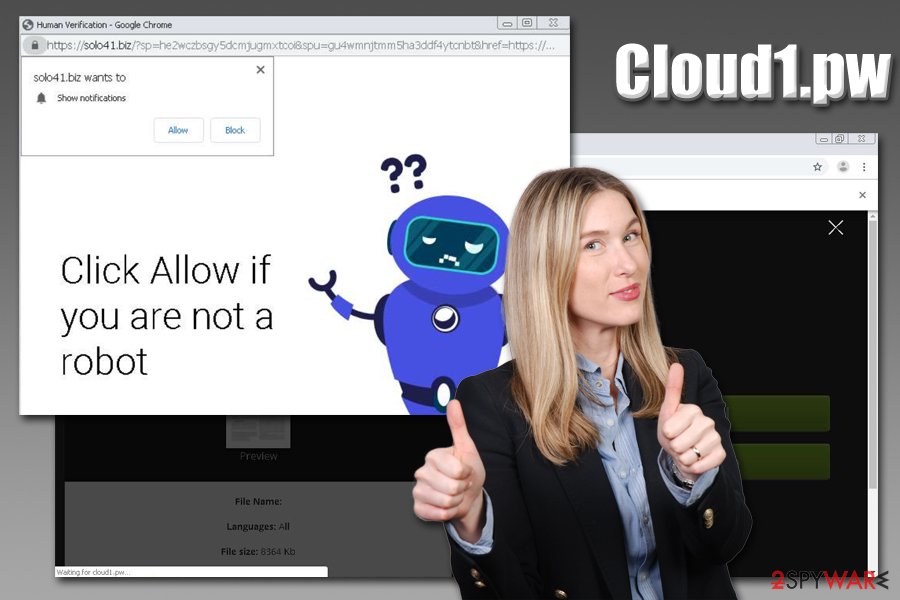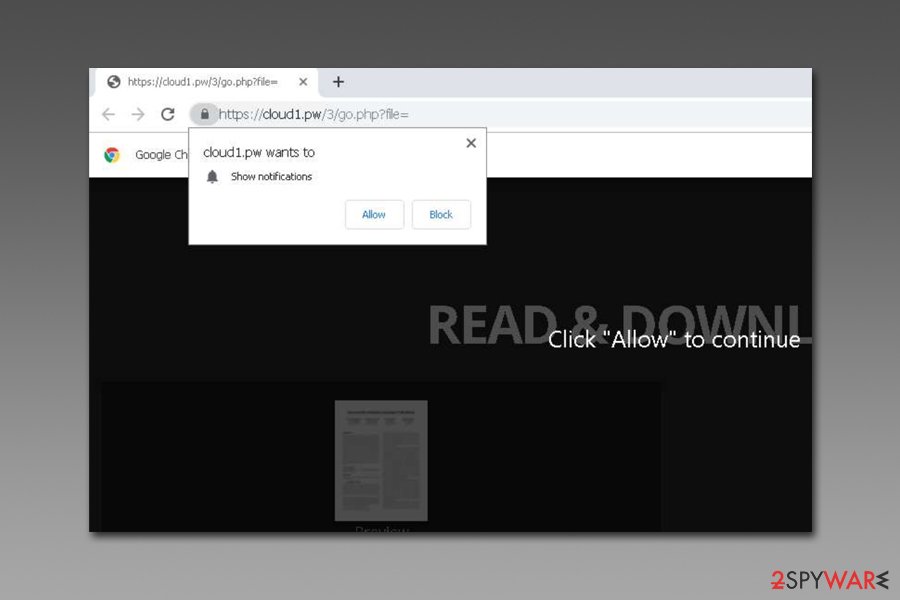Cloud1.pw (Virus Removal Guide) - Free Instructions
Cloud1.pw Removal Guide
What is Cloud1.pw?
Cloud1.pw is a push notification scam that can lead to intrusive ads even with Google Chrome, Mozilla Firefox, or another browser switched off

Cloud1.pw is a malicious website that employs social engineering[1] techniques in order to make users download files of unknown origin, collect their personal information and subscribe to notifications that would appear directly on users' desktops even if the web browser is not in use. Additionally, some users claimed that they encountered Cloud1.pw on Android phones and that persistent redirects led them to known websites.
Cloud1.pw ads and pop-ups can originate from two different sources: either the machine is infected with an adware[2] program that sneaked in without asking for direct permission, or that the notifications were accepted by pressing “Allow” on the site prompt. As a result, users might be spammed with pop-ups, deals, offers, banners, coupons, and other intrusive advertisements on Google Chrome, Safari, Mozilla Firefox, MS Edge, or another web browser. Some of the browser extensions, such as “Cloud Browser,” have been found connected to the unwanted background activity. In any case, we will explain Cloud1.pw removal methods in the bottom section below.
| Name | Cloud1.pw |
|---|---|
| Type | Adware, push notification virus |
| Infiltration | Adware is generally known to be spread along with other freeware apps from third-party sources or via fake updates; unwanted Cloud1.pw desktop notifications can be present as a result of allowing them via the browser prompt |
| Related | Cloud Browser extension |
| Symptoms | Advertisement banners appear on all websites that |
| Dangers | Infiltration of potentially unwanted software and malware, personal data disclosure to unknown parties/cybercriminals, loss of money due to frequently encountered scams, etc. |
| Termination | You can get rid of unwanted desktop notification by accessing settings panel of your browser; if a computer infection is involved, you need to terminate the adware or another PUP from your device by following the provided instructions below |
| System fix | Adware and malware can sometimes impact the computer system in a negative way – so much so that the OS would start crashing and being unstable. If that is the case, we suggest you use FortectIntego to fix the damage done by the virus and bring your computer back to normal |
Adware is based on the monetization form – it uses advertisements that are shown to thousands of users and gain revenue for each click or redirect to a particular site. Therefore, it is in the best interest of PUP developers to expose users to as much ad content as possible, and also for as many users as possible. That is where software bundling comes in, as it is a primary distribution method of adware programs like Cloud1.pw.
Once installed, a potentially unwanted program might change web browser settings without permission and start its advertising activities. While ads can be a great business model for app developers, they always contain risks, as there are plenty of shady advertising networks. As a result, the installed PUP may lead users to websites like tech support scams,[3] phishing, hacked, and other sites, including Cloud1.pw.
To make matters worse, the instantaneous Cloud1.pw notification prompt tries to convince users to enable ads by pressing the “Allow” button. Those who do, simply allow this dubious site to proliferate more advertisement content, although it is not showed within browsers anymore, but rather as desktop notifications. Unfortunately, many users don't know how to remove Cloud1.pw notifications from their desktops once they are enabled.

To make users click on “Allow,” malicious actors come up with various scam messages – such a well known “Click here if you are not a robot” verification method. To put it simply, Cloud1.pw combines two legitimate features to make users view ads constantly and bring money to its developers.
All in all, the reason you see redirects to Cloud1.pw might be due to adware infection, although desktop notifications might not be related to it all and be a result of allowing them via the browser prompt after accessing the site. To get rid of the Cloud1.pw virus, you should scan your machine with anti-malware software or follow a detailed guide below.
Note that resetting browsers will also stop the annoying Cloud1.pw notifications immediately. However, if you found adware on your machine, remove it as soon as possible. Also, for best results, experts recommend using FortectIntego repair tool.
Ways to avoid bundled software tricks
Many users are relatively surprised when they discover that the cause for ads, redirects, and other intrusive browsers behavior is actually a potentially unwanted program that is residing within their machines. In most cases, they will simply shake their heads and say that they never installed such applications themselves, and have no clue how it got there. The truth is, software bundling is to blame – a successful marketing campaign that incorporates several components within standalone installers.
While it is not illegal to offer users applications for free, the very controversial step of this process is the way it is done. In most cases, the optional components are suggested to users in a way that they are often missed, and most don't even notice that they were there in the first place. For that, several tricks are used, including pre-ticked boxes, misleading deals/offers, misplaced “Skip” or 'Next” buttons, fine print text, etc.
Therefore, during the installation of free software acquired from third-party sites, it is important to follow the process carefully and never skip steps. Saving a few minutes of the time can cause a major headache later, as malware can also be proliferated with the help of software bundling – previously, one of the uTorrent clients was found installation a cryptojacker on users' systems.[4]

Without a doubt, having a powerful anti-malware program installed on the machine is mandatory, as it can stop various parasites from entering in the first place. However, AV is no longer enough, and users should practice safe web browsing, downloading apps, opening emails, and other online behavior.
Cloud1.pw ads removal instructions
If you are seeing Cloud1.pw virus ads on your device, you most likely allowed the notifications from a suspicious website. Luckily, this can be fixed by entering your web browser settings and getting rid of the site's entry under the “Allowed notifications” field (note that resetting all the installed browsers as per instructions below would also remove Cloud1.pw pop-ups from your desktop). Here's how to do it:
Google Chrome
- Pick Menu and select Settings
- Click Advanced
- Under Privacy and security, click on Site Settings
- Choose Notifications
- Under Allow section, you should see Cloud1.p
- Select More Actions and click on Block
Mozilla Firefox:
- Select Menu and then Options
- Click on Privacy & Security and then go for Notifications
- Go to Settings – you should see Cloud1.pw entry
- Click on the the drop-down menu and select Block
- Click Save Changes
MS Edge:
- Go to More and pick Settings
- Select View advanced settings and then pick Advanced
- Go to Manage permissions
- Find Cloud1.pw and turn off notifications
If you are suffering from the same problem on your Android phone you can stop Cloud1.pw virus ads as follows:
- Tap on the three dots at the top-right corner of Chrome browser
- Select Settings
- Go to Site settings or/and Notifications
- Select which sites are [not] allowed to show you notifications
However, if you suspect the cause of unwanted browser behavior is adware, Cloud1.pw removal will require you to find a potentially unwanted program and delete it either manually or automatically. If you choose the first option, proceed with the instructions below. If you want a quick solution, download and install security software that has a PUP detection feature and perform a full system scan.
You may remove virus damage with a help of FortectIntego. SpyHunter 5Combo Cleaner and Malwarebytes are recommended to detect potentially unwanted programs and viruses with all their files and registry entries that are related to them.
Getting rid of Cloud1.pw. Follow these steps
Uninstall from Windows
To get rid of Cloud1.pw adware on Windows, please follow these steps:
Instructions for Windows 10/8 machines:
- Enter Control Panel into Windows search box and hit Enter or click on the search result.
- Under Programs, select Uninstall a program.

- From the list, find the entry of the suspicious program.
- Right-click on the application and select Uninstall.
- If User Account Control shows up, click Yes.
- Wait till uninstallation process is complete and click OK.

If you are Windows 7/XP user, proceed with the following instructions:
- Click on Windows Start > Control Panel located on the right pane (if you are Windows XP user, click on Add/Remove Programs).
- In Control Panel, select Programs > Uninstall a program.

- Pick the unwanted application by clicking on it once.
- At the top, click Uninstall/Change.
- In the confirmation prompt, pick Yes.
- Click OK once the removal process is finished.
Delete from macOS
macOS can also get infected with adware – perform the following actions to get rid of all PUPs:
Remove items from Applications folder:
- From the menu bar, select Go > Applications.
- In the Applications folder, look for all related entries.
- Click on the app and drag it to Trash (or right-click and pick Move to Trash)

To fully remove an unwanted app, you need to access Application Support, LaunchAgents, and LaunchDaemons folders and delete relevant files:
- Select Go > Go to Folder.
- Enter /Library/Application Support and click Go or press Enter.
- In the Application Support folder, look for any dubious entries and then delete them.
- Now enter /Library/LaunchAgents and /Library/LaunchDaemons folders the same way and terminate all the related .plist files.

Remove from Microsoft Edge
Delete unwanted extensions from MS Edge:
- Select Menu (three horizontal dots at the top-right of the browser window) and pick Extensions.
- From the list, pick the extension and click on the Gear icon.
- Click on Uninstall at the bottom.

Clear cookies and other browser data:
- Click on the Menu (three horizontal dots at the top-right of the browser window) and select Privacy & security.
- Under Clear browsing data, pick Choose what to clear.
- Select everything (apart from passwords, although you might want to include Media licenses as well, if applicable) and click on Clear.

Restore new tab and homepage settings:
- Click the menu icon and choose Settings.
- Then find On startup section.
- Click Disable if you found any suspicious domain.
Reset MS Edge if the above steps did not work:
- Press on Ctrl + Shift + Esc to open Task Manager.
- Click on More details arrow at the bottom of the window.
- Select Details tab.
- Now scroll down and locate every entry with Microsoft Edge name in it. Right-click on each of them and select End Task to stop MS Edge from running.

If this solution failed to help you, you need to use an advanced Edge reset method. Note that you need to backup your data before proceeding.
- Find the following folder on your computer: C:\\Users\\%username%\\AppData\\Local\\Packages\\Microsoft.MicrosoftEdge_8wekyb3d8bbwe.
- Press Ctrl + A on your keyboard to select all folders.
- Right-click on them and pick Delete

- Now right-click on the Start button and pick Windows PowerShell (Admin).
- When the new window opens, copy and paste the following command, and then press Enter:
Get-AppXPackage -AllUsers -Name Microsoft.MicrosoftEdge | Foreach {Add-AppxPackage -DisableDevelopmentMode -Register “$($_.InstallLocation)\\AppXManifest.xml” -Verbose

Instructions for Chromium-based Edge
Delete extensions from MS Edge (Chromium):
- Open Edge and click select Settings > Extensions.
- Delete unwanted extensions by clicking Remove.

Clear cache and site data:
- Click on Menu and go to Settings.
- Select Privacy, search and services.
- Under Clear browsing data, pick Choose what to clear.
- Under Time range, pick All time.
- Select Clear now.

Reset Chromium-based MS Edge:
- Click on Menu and select Settings.
- On the left side, pick Reset settings.
- Select Restore settings to their default values.
- Confirm with Reset.

Remove from Mozilla Firefox (FF)
make sure you reset Mozilla Firefox if you had adware installed on your machine:
Remove dangerous extensions:
- Open Mozilla Firefox browser and click on the Menu (three horizontal lines at the top-right of the window).
- Select Add-ons.
- In here, select unwanted plugin and click Remove.

Reset the homepage:
- Click three horizontal lines at the top right corner to open the menu.
- Choose Options.
- Under Home options, enter your preferred site that will open every time you newly open the Mozilla Firefox.
Clear cookies and site data:
- Click Menu and pick Settings.
- Go to Privacy & Security section.
- Scroll down to locate Cookies and Site Data.
- Click on Clear Data…
- Select Cookies and Site Data, as well as Cached Web Content and press Clear.

Reset Mozilla Firefox
If clearing the browser as explained above did not help, reset Mozilla Firefox:
- Open Mozilla Firefox browser and click the Menu.
- Go to Help and then choose Troubleshooting Information.

- Under Give Firefox a tune up section, click on Refresh Firefox…
- Once the pop-up shows up, confirm the action by pressing on Refresh Firefox.

Remove from Google Chrome
Delete malicious extensions from Google Chrome:
- Open Google Chrome, click on the Menu (three vertical dots at the top-right corner) and select More tools > Extensions.
- In the newly opened window, you will see all the installed extensions. Uninstall all the suspicious plugins that might be related to the unwanted program by clicking Remove.

Clear cache and web data from Chrome:
- Click on Menu and pick Settings.
- Under Privacy and security, select Clear browsing data.
- Select Browsing history, Cookies and other site data, as well as Cached images and files.
- Click Clear data.

Change your homepage:
- Click menu and choose Settings.
- Look for a suspicious site in the On startup section.
- Click on Open a specific or set of pages and click on three dots to find the Remove option.
Reset Google Chrome:
If the previous methods did not help you, reset Google Chrome to eliminate all the unwanted components:
- Click on Menu and select Settings.
- In the Settings, scroll down and click Advanced.
- Scroll down and locate Reset and clean up section.
- Now click Restore settings to their original defaults.
- Confirm with Reset settings.

Delete from Safari
Remove unwanted extensions from Safari:
- Click Safari > Preferences…
- In the new window, pick Extensions.
- Select the unwanted extension and select Uninstall.

Clear cookies and other website data from Safari:
- Click Safari > Clear History…
- From the drop-down menu under Clear, pick all history.
- Confirm with Clear History.

Reset Safari if the above-mentioned steps did not help you:
- Click Safari > Preferences…
- Go to Advanced tab.
- Tick the Show Develop menu in menu bar.
- From the menu bar, click Develop, and then select Empty Caches.

After uninstalling this potentially unwanted program (PUP) and fixing each of your web browsers, we recommend you to scan your PC system with a reputable anti-spyware. This will help you to get rid of Cloud1.pw registry traces and will also identify related parasites or possible malware infections on your computer. For that you can use our top-rated malware remover: FortectIntego, SpyHunter 5Combo Cleaner or Malwarebytes.
How to prevent from getting adware
Do not let government spy on you
The government has many issues in regards to tracking users' data and spying on citizens, so you should take this into consideration and learn more about shady information gathering practices. Avoid any unwanted government tracking or spying by going totally anonymous on the internet.
You can choose a different location when you go online and access any material you want without particular content restrictions. You can easily enjoy internet connection without any risks of being hacked by using Private Internet Access VPN.
Control the information that can be accessed by government any other unwanted party and surf online without being spied on. Even if you are not involved in illegal activities or trust your selection of services, platforms, be suspicious for your own security and take precautionary measures by using the VPN service.
Backup files for the later use, in case of the malware attack
Computer users can suffer from data losses due to cyber infections or their own faulty doings. Ransomware can encrypt and hold files hostage, while unforeseen power cuts might cause a loss of important documents. If you have proper up-to-date backups, you can easily recover after such an incident and get back to work. It is also equally important to update backups on a regular basis so that the newest information remains intact – you can set this process to be performed automatically.
When you have the previous version of every important document or project you can avoid frustration and breakdowns. It comes in handy when malware strikes out of nowhere. Use Data Recovery Pro for the data restoration process.
- ^ Social engineering (security). Wikipedia. The free encyclopedia.
- ^ Vangie Beal. Adware. Webopedia. Online Tech Dictionary for Students, Educators and IT Professionals.
- ^ How to Spot, Avoid and Report Tech Support Scams. FTC. Federal Trade Commission.
- ^ Do you use uTorrent? Careful with what it installs in your computer!. Panda security. Media Center.























